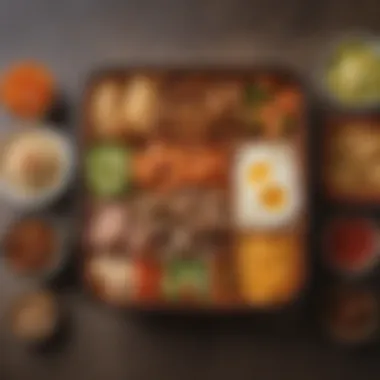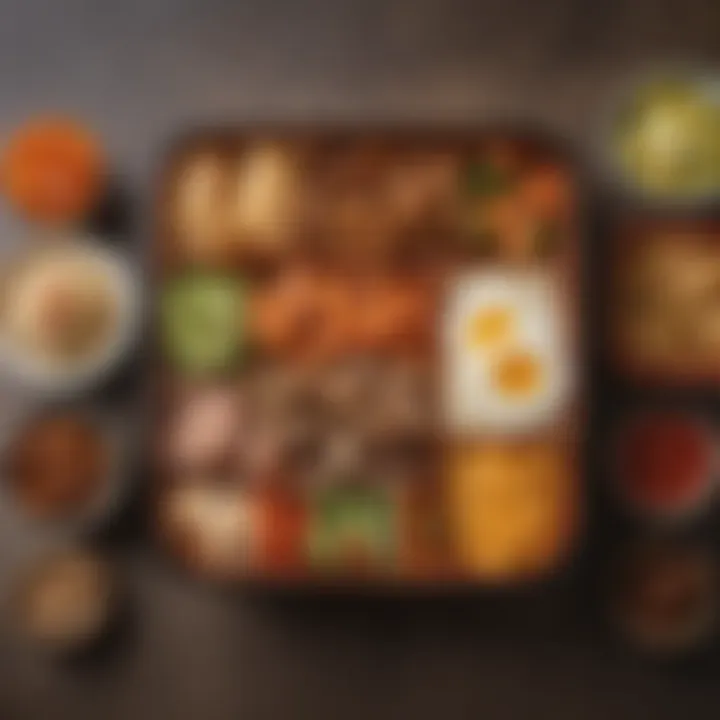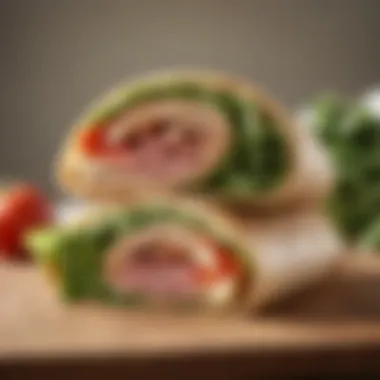Creative Lunch Ideas for Busy Preschool Parents


Intro
Navigating the world of preschool lunches can feel like walking a tightrope for busy parents. Balancing nutritional needs with the ever-evolving tastes of little ones is no small feat. As children transition into their own personalities, their culinary preferences begin to whittle down to the familiar, often leaving parents scrambling for ideas that won't lead to a mealtime standoff.
In this ever-changing landscape of kid-friendly fare, innovative lunch ideas come into play, allowing parents to creatively engage with healthy ingredients while keeping the experience fun and appealing for their preschoolers. This article provides practical guidance on crafting lunches that pack a punch of flavor and nutrition, without consuming valuable time and energy.
With our insights, parents will find themselves equipped with quick recipes that utilize a range of food groups while steering clear of the dreaded food waste. Kids will enjoy delightful combinations they can proudly show off in their lunchboxes, and parents will breathe easier knowing they’re fueling little bodies with wholesome goodness. Let's dive into some appetizing options that can easily become staples in your lunch rotation.
Considerations for Planning Prek Lunches
Planning lunches for preschool children might seem like a simple task, but it requires careful thought and consideration. First and foremost, these lunches must be nourishing. Little ones are on the move all day, and they need sustenance that not only fills their bellies but also supports their growth and development. By focusing on balanced meals that include proteins, grains, and plenty of fruits and vegetables, parents will ensure their children have the energy to play and learn.
In today's world, as families become increasingly busy, the idea of meal prep can feel overwhelming. Streamlining the lunch planning process is vital, as it allows parents to spend more quality time with their children during mealtime, rather than stressing about what to pack. Consider the time a parent has available in the morning; organizing the lunch box in advance can save precious minutes.
Another key element in the planning process is being conscious of dietary restrictions that may exist for some children. Whether due to allergies or personal preferences, understanding these limitations keeps lunchtime safe and enjoyable. By emphasizing variety in their meal selections, parents ensure that their kids won’t feel bored with their food, making them more likely to eat what’s offered.
By weaving these considerations into their lunch plans, parents step into the role of nurturers and educators. They introduce flavors and foods that can foster a healthy relationship with nutrition.
"In the kitchen, we teach children far beyond the basics of nutrition; we teach them about variety, colors, and even cultures."
Nutritional Needs of Preschool Children
Preschoolers have unique nutritional requirements. During these formative years, children ages three to five are growing rapidly, and their diets need to reflect this. One of the most critical points to remember is that kids need a mix of nutrients, including calcium, iron, and vitamins. Understanding food groups can help parents create well-balanced lunches.
For instance, dairy products contribute calcium essential for bone growth, while lean proteins build their muscles. Whole grains provide the energy needed for their playful activities, and colorful fruits and veggies supply important vitamins and antioxidants. Simple choices can make a significant difference, like adding carrot sticks or apple slices along with their sandwiches.
Understanding Dietary Restrictions
When it comes to food, it’s a unique landscape for every child. Some may have allergies or intolerances to common ingredients such as peanuts or dairy, while others might follow specific diets for health or cultural reasons. It's crucial for parents to pay attention to their child’s individual needs and to communicate openly about food preferences.
By getting to know your child's friends and their dietary habits, parents can broaden their understanding and make sure no child feels left out during lunch. For example, if a child is gluten-intolerant, alternatives like rice cakes or gluten-free wraps can come into play. Awareness of these variances not only promotes inclusivity but can also turn lunchtime into a learning opportunity about diverse foods and culture.
Incorporating Variety
Never underestimate the power of variety. Kids are visual eaters; they tend to gravitate towards meals that are colorful and visually engaging. Mixing textures and flavors can inspire excitement about food. Instead of a standard peanut butter and jelly sandwich, why not try a wrap with spinach, turkey, and cheese? Or even better, a colorful bento box filled with sliced fruits, nuts, and cheese cubes.
Here are some simple ways to incorporate variety into PreK lunches:
- Use different spreads like hummus or avocado in place of mayonnaise.
- Rotate proteins weekly - chicken, turkey, legumes, or even fish can keep the palate engaged.
- Choose seasonal fruits and veggies to align with what’s fresh and locally available, making every meal unique.
By understanding and prioritizing these considerations, parents can deliver delightful and nutritious lunches that not only satisfy their little ones' bellies but also feed their curiosity for food.
Simple, Wholesome Recipe Ideas
In the hustle and bustle of daily life, crafting delicious and nutritious lunches for preschoolers can feel like an uphill climb for busy parents. This section digs into Simple, Wholesome Recipe Ideas, emphasizing the significance of preparing meals that aren’t just quick but also provide a well-rounded dose of nutrition to youngsters.
When you get right down to it, children’s food preferences can swing like a pendulum, often changing from one week to the next. That’s why focusing on wholesome recipes is vital. A well-balanced lunch isn't just about filling little tummies; it’s about fostering healthy eating habits early on. These recipes need to be engaging, colorful, and packed with nutrients that fuel their growing bodies and inquisitive minds.
Creative Sandwich Alternatives
Sometimes a traditional sandwich just won’t cut it, so why not think outside the bread box? These creative alternatives can shake things up a bit.


Wraps with Spinach and Hummus
Wraps with spinach and hummus bring vibrancy to the lunchbox. The green spinach serves as a nutritious base, providing iron and vitamins, while hummus adds a creamy texture and a delightful flavor. Both of these components are rich in nutrients that keep energy levels steady throughout the day.
What stands out here is how easy these wraps are to make. You can roll them up quickly, and kids can even assist in constructing their own! This interactive approach encourages them to take ownership of their food, which could improve the chances they’ll actually eat it. A potential downside though—if not stored well, the wrap could become soggy by lunchtime.
Pita Pockets Loaded with Veggies
Pita pockets offer a fun twist on the conventional lunch. These little pockets create a sunny garden for an array of vegetables. Think crayons of bell peppers, jewels of cherry tomatoes, and even the crunch of cucumber. This variety not only excites the taste buds but also introduces diverse nutrients.
One of the standout features of pita pockets is their portability. They’re easy to handle and can be stuffed with all sorts of goodies. However, ensure they’re not overloaded, or you might end up with a mini-food disaster when your kid bites in!
Flatbreads with Turkey and Cheese
Flatbreads equipped with turkey and cheese provide a more adult-like feel to kids’ lunches. The savory turkey delivers protein that helps in muscle growth, while cheese offers calcium essential for strong bones. Plus, the crispy texture of the flatbread adds an enjoyable crunch to each bite.
Flatbreads are intuitive; you can easily layer on toppings according to personal tastes. However, keep in mind that these are best consumed fresh; if left for too long, the bread might lose its delightful crispness and become a bit less appealing.
Nutritious Grain Bowls
Grain bowls can pack a punch in terms of flavors and textures, all while being simple to prepare.
Quinoa Salad with Chickpeas
Quinoa salad with chickpeas is an absolute powerhouse. Quinoa is a complete protein, meaning it contains all nine essential amino acids. When combined with chickpeas, this dish becomes a fulfilling option that keeps kids satiated without the crash that sugary snacks often induce.
The beauty of this salad lies in its adaptability; toss in whatever seasonal veggies are lying around. A downside might be that some kids can be tentative when it comes to trying new grains or legumes.
Brown Rice Bowl with Broccoli
Brown rice bowls with broccoli are a splendid way to incorporate fiber-rich grains into lunchtime. Brown rice holds the fort with its nutty flavor, while broccoli brings a vibrant green crunch. This dish can be made more exciting with a dash of soy or sesame sauce, enhancing those flavors that dance in their mouths.
The fibrous nature of both components aids in digestion, which is more than just a bonus. On the flip side, if your young one isn’t fond of broccoli, trying other veggies might be necessary.
Oats with Fruits
Moving beyond the stereotype of breakfast food, oats with fruits can create a grand slam of taste and nutrition at lunchtime. Oats are fiber-rich and work wonders for keeping energy levels stable, and pairing them with fresh fruits throws in added vitamins and textures. Plus, they can be prepared the night before, giving you some breathing space in the morning.
However, some might argue that oats can become mushy if left too long, so a good balance of the fruit-to-oats ratio is key here.
Smoothies as Lunch Options
Smoothies offer endless possibilities and are easy to customize. A smoothie can be a quick lunch option—blend fruits like bananas and berries with yogurt or milk for a thick, nutritious drink. One standout benefit is the ease with which they can be packed with fruits, veggies, and proteins, all while looking like a tasty treat.
Though quick to prepare, the potential caveat here is that once served, it’s best consumed promptly due to separated textures and flavors. Some children might also hesitate to enjoy drinks as a lunch option, preferring solid foods.
Remember, meals crafted in fun, colorful ways often draw more appeal to preschoolers, leading them to broader food acceptance.
In sum, Simple, Wholesome Recipe Ideas carry significant weight for both mealtime delight and nutrition. It's all about striking the right balance between convenience, taste, and health, ensuring that kids are excited for lunch while also getting the necessary nutrients.
Efficient Meal Preparation Strategies
When it comes to preparing lunches for preschoolers, efficient meal prep strategies can turn chaos into calm. For busy parents, the key lies in planning meals that not only meet the nutritional needs of their children but also fit seamlessly into their daily routines. The benefits of effective meal preparation go beyond just saving time; it helps to reduce stress and ensures that healthy food options are always at hand.


Adopting efficient prep techniques can make a significant difference. These strategies encourage parents to go beyond just throwing together last-minute snacks, guiding them towards thoughtful, nutritious choices that children will enjoy.
Batch Cooking Techniques
Batch cooking is a highly effective way to prepare multiple meals in one go. Think of it as cooking once and eating multiple times, which can be a lifesaver for parents with tight schedules. The process typically involves selecting certain recipes that can be made in larger quantities. For instance, cooking a big pot of chili or a casserole can not only cater to lunch but can also double as dinner.
In addition, meals that freeze well are ideal candidates for batch cooking. Soups, stews, and grain salads can be made in large quantities, divided into smaller portions, and frozen for later use. Just remember to label and date each container - having a well-organized freezer means less searching at mealtime.
Utilizing Leftovers
Leftovers are often seen as an afterthought, but they can actually save time and prevent food waste. Instead of merely reheating previous meals, think about how they can be transformed into something new and exciting. For example, leftover roasted chicken can easily be shredded and tossed into a wrap with some veggies and a dollop of yogurt. Similarly, unused grains can serve as a base for grain bowls, complete with fresh toppings.
The idea is to embrace creativity. A little imagination can turn yesterday’s food into today's gourmet creations. Keeping an eye on what’s available and thinking outside the box can minimize waste and provide ample opportunities to enhance your little one’s lunch options.
Planning Ahead
One of the most overlooked aspects of efficient meal prep is planning ahead. This involves not just thinking about meals for the week, but also engaging children in the process. Allowing them to help plan and shop for their lunches can make them more excited about eating what’s prepared. You might want to involve them in picking fruits or veggies that they like, which often leads to more varied, colorful lunches.
Creating a simple chart or calendar for meal planning can be incredibly helpful. Parents might also find it beneficial to establish a theme for each day, like "meatless Monday" or "wrap it Wednesday," making lunches more interesting and cohesive. Having a plan can alleviate the last-minute rush, making lunch prep faster and more enjoyable.
"Good planning is the foundation of all success. A little foresight can change the entire lunch experience."
In summary, efficient meal preparation strategies empower busy parents, ensuring that preschoolers have a range of healthy and delicious lunch options every day. From batch cooking and inventive use of leftovers to effective planning, these techniques not only simplify the cooking process, they also enhance the overall lunchtime experience for parents and children alike.
Incorporating Seasonal Ingredients
Integrating seasonal ingredients into your preschooler’s lunch not only makes sense from a nutritional standpoint but also adds a delightful variety to everyday meals. By working with produce that’s at its peak, you’re not just feeding your child; you’re expanding their palate and nurturing an appreciation for what the world has to offer throughout the year. It’s about making lunches not just food, but experiences that connect children to the rhythm of nature.
Understanding Seasonal Produce
When we speak about seasonal produce, it's worthwhile understanding what is ripe when. Each season brings its own bounty that can inspire the lunchbox. In spring, tender greens like spinach and peas make their debut, while summer bursts forth with tomatoes and berries, full of flavor. As autumn rolls around, root vegetables such as carrots and potatoes make perfect sides. Finally, winter offers hearty greens like kale that can be stored and enjoyed across the colder months.
The concept of eating seasonally ties closely with what’s freshest, often translating into better taste and nutritional value. You can even involve your little ones in the selection process: going to the local farmers’ market can be a fun outing where they learn about fruits and vegetables while picking out ingredients for the week.
Benefits of Cooking with the Seasons
The advantages of cooking with seasonal ingredients are plentiful:
- Freshness and Flavor: Simply put, in-season fruits and vegetables taste better. They’ve had the chance to ripen naturally, often absorbing more sun and moisture, making them sweeter and juicier.
- Nutritional Value: Seasonal produce is generally harvested at its peak, which means it retains more nutrients. Feeding your child an assortment of veggies and fruits helps offer all necessary vitamins and minerals for healthy growth.
- Economic Savings: Often, foods that are in-season are also cheaper. When supply is abundant, prices drop, helping you stay within budget without compromising quality.
- Environmental Impact: Eating what's in season can also lower your carbon footprint. Seasonal produce often requires less transportation and can contribute to a more sustainable food system.
"Eating seasonally encourages a connection to the land and promotes a sustainable lifestyle."
In creating lunches that are both appealing and nourishing, consider incorporating foods that are currently available and at their best. You need not force exotic items into the mix that may not only be costly but also lack freshness missing the mark on nutrition and taste.
By experimenting with ingredients as they come in and out of season, lunchtime can become a creative endeavor that just might inspire your child to be more adventurous with food. A seasonal sheet of produce offered every few weeks can help you maintain variety while teaching valuable lessons about nature’s cycles.
Lunch Accessories and Ideas
When it comes to packing lunches for preschoolers, the containers and presentation matter just as much as the food itself. Parents often find themselves juggling numerous tasks, making it easy to overlook how accessories can enhance the lunchtime experience. Using innovative lunch containers and embellishing meals with fun presentation techniques can not only make food more appealing to young children but also simplify the packing process.
Innovative Lunch Containers
The right lunch container can be a game-changer in ensuring that meals are stored effectively and remain fresh. There’s a world of options out there, from bento boxes to insulated thermoses, each tailored to different kinds of meals. Many of these containers are sectioned off, allowing parents to pack a balanced meal with small portions of various foods. This aspect helps in ensuring that kids get a taste of everything without dealing with overwhelming portions.


Some containers even come with ice packs, keeping items like yogurt or cut fruits cool until it's lunch time. Choosing colorful or character-themed containers can also make a difference. They often entice little ones to dig in. A lunch packed in a bright, fun container can often feel like a special treat, encouraging preschoolers to eat what’s been prepared.
- Bento Boxes: These are great for portion control and variety. They allow for a colorful assortment of food, pleasing the eyes and taste buds alike.
- Insulated Lunch Bags: Perfect for keeping items at the right temperature, good for both hot and cold meals.
- Leak-Proof Containers: Especially useful when packing items like yogurt or soups, sparing parents the mess of unexpected spills.
Investing in a set of reliable lunch containers can save parents a lot of hassle and ensure their children are excited for lunchtime.
Fun Presentation Techniques
Presentation isn’t just for fancy restaurants—it has a significant role in how children view their meals. Engaging kids with visually appealing presentations can spark curiosity and make lunchtime much more stimulating. Tiny details can turn a simple meal into a culinary adventure for a child. For instance, using cookie cutters to shape sandwiches into stars or animals can make the meal much more enticing.
Arranging food in a rainbow pattern can be another captivating technique, particularly with fruits and veggies. Here are some ideas to make the mealtime experience pop:
- Use Colorful Utensils: Bright plates or forks and spoons can add an element of fun.
- Food Art: Transform food into creatures or characters, using fruits and vegetables to create faces.
- Themed Lunches: Pick a theme such as “Under the Sea” with fish-shaped sandwiches and blue jello for water. This creates excitement and anticipation around mealtime.
"Visual appeal can transform a simple lunch into an experience, enticing children to explore and try new foods."
Ultimately, the key to keeping preschoolers interested in their lunches lies in the small details—from choosing the right containers to presenting the food in creative ways. Such simple yet effective strategies can make lunchtime an enjoyable ritual, rather than a routine chore.
Addressing Picky Eaters
When it comes to feeding preschoolers, encountering picky eaters is nearly a rite of passage for parents. This behavior often stems from a child's natural curiosity and their limitations in coping with new flavors and textures. The art of addressing these picky tendencies can make lunch preparation a more enjoyable experience for both parents and children. Understanding this topic is crucial because it not only nurtures the child's nutritional needs but also promotes a healthier relationship with food.
Children at this age are developing tastes and preferences that can last well into adulthood. By proactively engaging with picky eaters, parents can lay a solid foundation for proper dietary habits. This can also help to reduce mealtime conflict, making the lunch experience more pleasurable.
Tactics for Engagement
Engaging with picky eaters might feel like trying to negotiate with a stubborn mule at times, but it can be done. Here are a few strategies to consider:
- Involve Kids in the Making: Letting children take part in lunch preparation often opens their minds to trying what they’ve helped create. Whether it’s assembling their wraps or selecting veggies, this involvement can ignite their interest.
- Create a Taste Test Challenge: Presenting a small variety of foods for them to try, perhaps with a playful twist, can spur excitement. Label the foods creatively - "Power-up Peppers" or "Superhero Spinach" - to intrigue them into tasting.
- Use a Reward System: Gentle encouragement can go a long way. Maintain a chart for trying new foods, offering smiles or stickers instead of treats. Small rewards can motivate them to branch out.
- Model Positive Eating Behavior: Children are astute observers. If they see caregivers enjoying a range of foods, they may be more inclined to sample what's on their plate.
Introducing New Foods Gradually
Transitioning a picky eater into embracing new foods requires patience and a plan. Gradual introduction works wonders. Here’s how you can go about it:
- Start Small with Familiar Flavors: Introduce new foods by pairing them with items they already enjoy. For instance, if your child likes peanut butter, try spreading it on whole grain bread while adding thin slices of banana. This familiar flavor can ease the transition.
- One New Food at a Time: Bombarding a child with too many new flavors at once might backfire. Instead, focus on one new item per meal and give them time to adjust.
- Keep It Visible and Accessible: Placing new foods in sight can stimulate curiosity. Consider putting colorful fruit in a bowl on the table, making them more likely to reach for it.
- Talk with Enthusiasm About the Food: Kids appreciate storytelling. Share fun facts about the food’s origin or how it benefits their body. Say things like, "Did you know carrots help you see in the dark?" This spark can make them more interested in trying it.
Out of all debates during mealtime, the struggle with picky eaters can be the most daunting. Yet, these tactics not Only help in broadening their palate but also boost their confidence in trying new foods. The path is not always smooth, but a little creativity mixed with understanding can turn lunchtime into an exciting exploration of flavors.
Final Tips for Successful Lunches
When it comes to crafting the ideal lunch for preschoolers, heading towards uncharted territory—while keeping it simple—can make the task feel less daunting. This section emphasizes the importance of balance and involvement. After all, successful lunches serve not only to nourish but also to delight young taste buds.
Maintaining Balance and Variety
Finding that sweet spot of balance in nutrients is crucial. Kids are still growing, and their bodies require a rainbow of vitamins, minerals, and energy. A well-rounded meal should include several key food groups: protein, fruits, vegetables, whole grains, and healthy fats.
- Protein Options: Think about eggs, lean meats, beans, or tofu. Even a dollop of peanut butter can work wonders.
- Fruits and Veggies: Always aim for two servings of colorful produce. Slicing fruits into fun shapes can also amp up the appeal.
- Whole Grains: Brown rice, whole grain bread, or oats can fill those little tummies and keep them satisfied until snack time.
- Healthy Fats: A sprinkle of seeds or a few slices of avocado can make a big difference.
Variety is equally important. Kids can promptly tire of the same old fare, leading to meal-time battles. By rotating ingredients and flavors weekly, you'll keep their culinary curiosity alive. Try different dips for veggies. Hummus one week and yogurt another. Even changing up the way you serve can spark interest—skewers or mini sandwiches make everything more fun.
Engaging Children in the Process
Children love to feel involved, and letting them participate in meal prep can do wonders for their willingness to try new dishes.
- Involve Them in Planning: Give them options when deciding on what to include for lunch. Should we have wraps or pita bread? Chicken or hummus? Letting them have a say gives a sense of ownership.
- Cooking Together: Simple tasks like washing veggies or mixing ingredients can be enjoyable. It encourages them to take pride in their food.
- Themed Lunches: Consider having days where you explore different countries’ cuisines or reinvent classic favorites. Concept lunches make lunchtime an adventure—Italian pasta salad one day, Japanese sushi rolls the next.
"Involving children in their food journey can lead to them making healthier choices as they grow. They become explorers rather than executors at the table."
Keeping these tips in mind can make a world of difference for busy parents trying to nourish their little ones. Balancing nutrition while keeping meals exciting is more than just a challenge; it’s an opportunity to bond and create positive memories around food.







